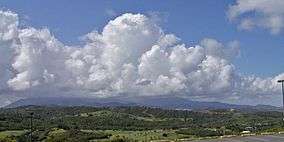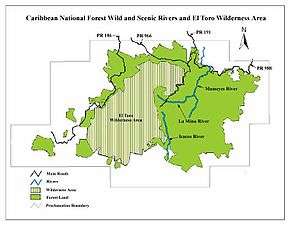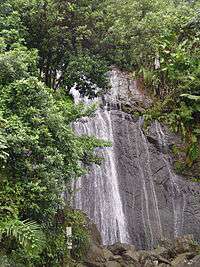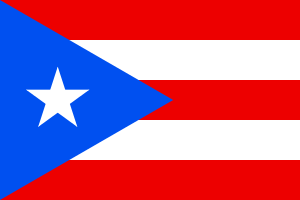El Yunque National Forest
| El Yunque National Forest | |
|---|---|
|
IUCN category VI (protected area with sustainable use of natural resources) | |
 | |
| Location | Puerto Rico, United States |
| Nearest city | Río Grande |
| Coordinates | 18°19′00″N 65°47′00″W / 18.31667°N 65.78333°WCoordinates: 18°19′00″N 65°47′00″W / 18.31667°N 65.78333°W |
| Area | 28,434 acres (115.07 km2)[1] |
| Established | January 17 1903 |
| Visitors | 600,000 [2] (in 2005) |
| Governing body | U.S. Forest Service |
| http://www.fs.usda.gov/elyunque/ | |
El Yunque National Forest, formerly known as the Luquillo National Forest and the Caribbean National Forest,[3] is a forest located in northeastern Puerto Rico. It is the only tropical rain forest in the United States National Forest System.[4] The forest is commonly known as El Yunque, which may be attributed to either a Spanish approximation of the aboriginal Taíno word yu-ke which means "white lands", or the word "anvil," which is yunque in Spanish. The second-tallest mountain within El Yunque is also named El Yunque. El Yunque National Rainforest is located on the slopes of the Sierra de Luquillo mountains, encompassing 28,000 acres (43.753 mi2 or 113.32 km2) of land, making it the largest block of public land in Puerto Rico. El Toro, the highest mountain peak in the forest rises 1,065 metres (3,494 ft) above sea level. Ample rainfall (over 200 inches a year in some areas) creates a jungle-like setting — lush foliage, crags, waterfalls, and rivers are a prevalent sight. The forest has a number of trails from which the jungle-like territory's flora and fauna can be appreciated. El Yunque is also renowned for its unique Taíno petroglyphs.
History

The forest region was initially set aside in 1876 by the King Alfonso XII of Spain, and represents one of the oldest reserves in the Western Hemisphere. It was established as the Luquillo Forest Reserve on 17 January 1903 by the General Land Office with 65,950 acres (266.9 km2), and became a National Forest in 1906. It was renamed Caribbean National Forest on 4 June 1935.[5] It is home to over 200 species of trees and plants, 23 of which are found nowhere else. The critically endangered Puerto Rican amazon (Amazona vittata), with an estimated wild population of 30 individuals, occurred exclusively in this forest until 19 November 2006, when another wild population was released by the Department of Natural Resources in the municipality of Utuado's Río Abajo State Forest.
An executive order signed by President George W. Bush on 2 April 2007 changed the name of the Caribbean National Forest to El Yunque National Forest, better reflecting the cultural and historical feelings of the Puerto Rican people.[6]
Climate
Because Puerto Rico is south of the Tropic of Cancer, it has a tropical climate. There is no distinct wet or dry season in El Yunque; it rains year round. The temperature and length of daylight remain fairly constant throughout the year. The average temperature year-round is 80 degrees Fahrenheit (high) and 70 degrees Fahrenheit (low). All of these factors provide a year-round growing season.
Ecology and conservation

Its ecosystem is specifically surveyed by the Management Team of Ecosystems (Equipo de Manejos de Ecosistemas), which is led by Pedro Rios.[7] Due to its location in the northeastern part of Puerto Rico, the incoming trade winds from the Atlantic Ocean bash into the mountains, leading to an excess of rainfall registered at about 6 metres (240 in) per year.[7] This process is called orographic lift and accounts for the intense rainfall and constant cloud presence in this mountainous region. This constant cloud cover and persistent winds produced by the adiabatic process of air particles rushing up through the mountainside has affected the morphology of El Yunque, but the most effect has been on the bosque enano or dwarf forest.[8]
Flora
El Yunque is composed of four different forest vegetation areas: Tabonuco Forest, Palo Colorado Forest, Sierra Palm Forest, and Dwarf Forest. The following image shows the green wilderness of El Yunque from one of its peaks; Pico El Yunque.
Dwarf forest
The Dwarf forest ecosystem is located at around 900 metres (3,000 ft) and composes the smallest sub-region in El Yunque. The forest is characterized by the variation of vegetation that is only found in Puerto Rico. The vegetation shows stunted growth in which the diameter of the trunk is widened and the number of leaves on the branches is lower than expected.[8] Other specific factors that affect the growth of this sub-region are the high level of acidity and poor water runoff from the soil.
Although many species have adapted to these harsh environments, five species are frequent in the dwarf forest: Ocotea spathulata, Tabebuia rigida, Calyptranthes krugii, Eugenia borinquensis and Calycogonium squamulosum. The other abundant type of plants in the dwarf forest are epiphytes. El Yunque supports a vast array of animal and plant life that varies depending on the altitude range in the rainforest. The great amount of competition in the canopy does not allow lower level plants to develop and prosper.[9] The characteristic of having a widened tree trunk is ideal for epiphytes that require a host to live. Therefore, a substantial amount of epiphytic plants have cemented their existence in the flora of El Yunque, specifically in the dwarf forest due to the moisture, precipitation and protection from the sun.
Fauna
Coqui

Approximately 15 species of common coqui, members of the diverse neotropical frog genus Eleutherodactylus, are known on Puerto Rico. Of these 15, 13 have been found in El Yunque National Forest.[10] This small frog earned its Puerto Rican common name due to the call of the most common coquí species on Puerto Rico, Eleutherodactylus coqui, which begins as the sun sets and ends in early dawn. This has made it an animal of great endearment to Puerto Ricans.
Although the coquí is an amphibian, it possesses some features that are unusual in frogs. These differences are seen mainly in its morphology, reproduction, and developmental stages. In terms of morphology, the coquí does not have webbing between its toes because it is a tree dweller in moist environments. Another significant difference is that it does not have a definite larval stage, and the eggs laid by the female are terrestrial instead of aquatic.[10] This means that a miniature frog-let, rather than a tadpole, arises from the incubation period.
Birds
El Yunque is one of the two locations with populations of the elfin woods warbler, the other being Maricao State Forest. The species was first discovered in El Yunque. This species of bird is endemic to Puerto Rico and first described in 1972; it inhabits the dwarf (or "elfin") forest at high elevations in El Yunque.
The Puerto Rican amazon, a critically endangered parrot endemic to Puerto Rico, is also found in El Yunque, and for some time, was only known to occur here.
El Portal Rain Forest Center
Opened in 1996, the El Portal Rain Forest Center is designed to give visitors an introduction to the rain forest. A walkway set at 60 feet (18 m) above the ground allows for a view of the tops of trees, and another walkway winds along tree bases. Exhibits at the center focus on the plants and animals of the rain forest, the importance of rain forests around the world, and threats to rain forests and efforts to conserve them.[11]
Miscellaneous
There is a common misconception that El Yunque National Forest is the only rainforest in the United States National Forest System (NFS).[note 1] However, this is not the case. There are other rainforests in the National Forest System, including those in Alaska (Example: Tongass National Forest) and the Pacific Northwest (Example: Mount Hood Wilderness) as stated in the US Forest Service website.[12] As El Yunque's own official website states, El Yunque is the only tropical rainforest in the System, but it is not the only rainforest.[13] There are two observation towers including Yokahu Tower and Mount Britton Tower.
El Yunque National Forest was chosen to be Puerto Rico's entry in the America the Beautiful Quarters program. Its only National Park Service site, San Juan National Historic Site had already been featured on the District of Columbia and United States Territories Quarters in 2009.
In 2002, the U.S. Congress designated areas bounded by the Río Mameyes, Río de la Mina, and Río Icacos in the Caribbean National Forest as components of the National Wild and Scenic Rivers System.[14]
See also
 Puerto Rico portal
Puerto Rico portal
- El Toro Wilderness
- El Yunque, Puerto Rico - the mountain peak
- Puerto Rican moist forests - ecoregion
- America the Beautiful Quarters
Notes
- ↑ See, for example, Puerto Rico - Nature and Scientific Wonders. Smithsonian Institution. 6 November 2007. Retrieved 15 August 2013; Frommer's Puerto Rico. Frommer's Introduction to El Yunque. Retrieved 15 August 2013;Puerto Rico Chapter Marks Milestones, Looks Ahead. Sierra Club. Retrieved 15 August 2013;Hiking in Puerto Rico. Matthew Gilbertson and Amanda Morris. 25 March 2011. Retrieved 15 August 2013.
References
- ↑ "Land Areas of the National Forest System" (PDF). U.S. Forest Service. January 2012. Retrieved June 28, 2012.
- ↑ "Puerto Rico". Fly Eat Travel Blog. Retrieved 2014-08-27.
- ↑ "History & Culture". U.S. Forest Service. Retrieved 2012-02-01.
- ↑
 This article incorporates public domain material from the United States Department of Agriculture document "El Yunque National Forest" (retrieved on November 28, 2015).
This article incorporates public domain material from the United States Department of Agriculture document "El Yunque National Forest" (retrieved on November 28, 2015). - ↑ Davis, Richard C. (2009-09-29). "National Forests of the United States" (PDF). The Forest History Society.
- ↑ "Executive Order: Renaming a National Forest in the Commonwealth of Puerto Rico". Business Wire. 2007-04-02. Retrieved 2008-12-04.
- 1 2 "About the Forest". U.S. Forest Service. Retrieved 2011-06-11.
- 1 2 Weaver, Peter L. (2008). "Dwarf Forest Recovery After Disturbance in the Luquillo Mountains of Puerto Rico". Caribbean Journal of Science. 44 (2): 150–163.
- ↑ Mohlenbrock, Robert H. (October 1991). "Epiphytes of El Yunque, Puerto Rico". Natural History: 76.
- 1 2 Burrowes, Patricia A.; Ana V. Longo (June 2010). "Persistence with Chytridiomycosis Does Not Assure Survival of Direct-developing Frogs". EcoHealth: 185–195.
- ↑ "Explore El Portal Tropical Forest Center in El Yunque Forest". PuertoRico.com. Retrieved 2012-02-01.
- ↑ Retrieved 15 August 2013.
- ↑ Retrieved 15 August 2013.
- ↑ Caribbean National Forest Wild and Scenic Rivers Act of 2002. H. R. 3954. One Hundred Seventh (107th) Congress of the United States of America. SECOND SESSION (2nd Session). (PUBLIC LAW 107–365. DEC. 19, 2002. 116 STAT. 3027) 23 January 2002. Retrieved 13 August 2013.
Further reading
- Manuel, Víctor (2010). El Yunque (in Spanish) (First ed.). Impressive Publications. ISBN 978-0-9825402-6-8.
- Manuel, Víctor (2011). El Yunque (Second ed.). Impressive Publications. ISBN 0-982-5402-6-4.
External links
| Wikimedia Commons has media related to El Yunque National Forest. |